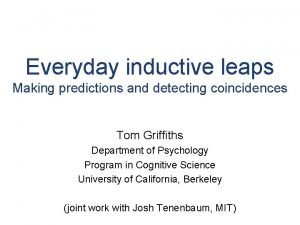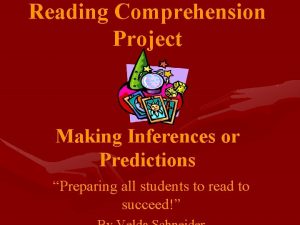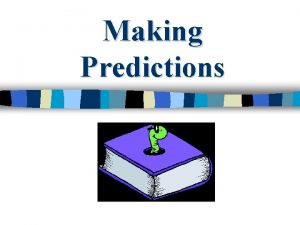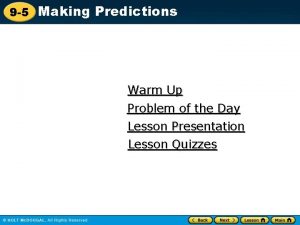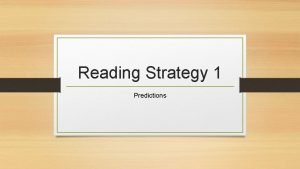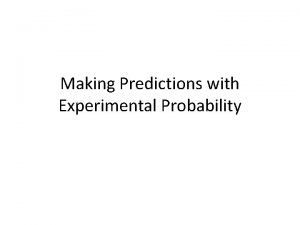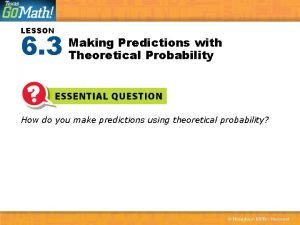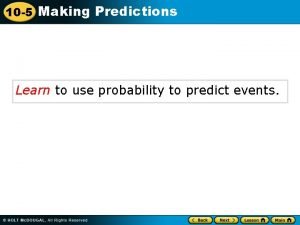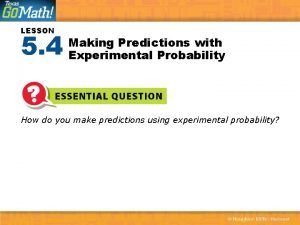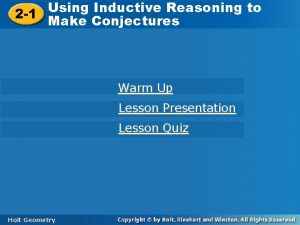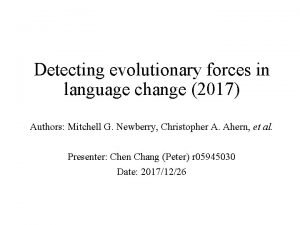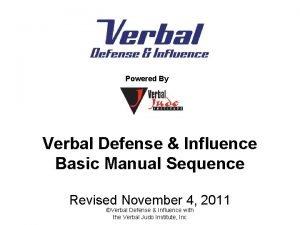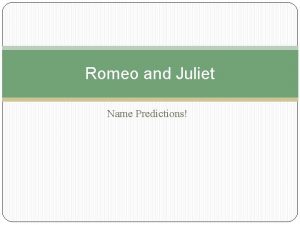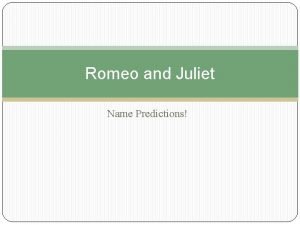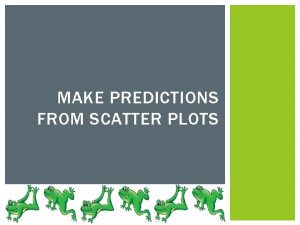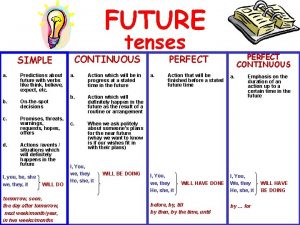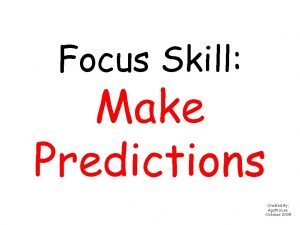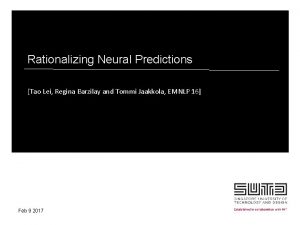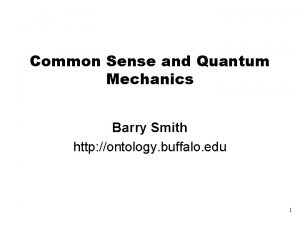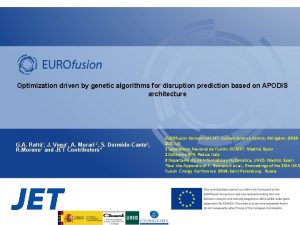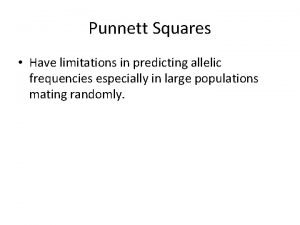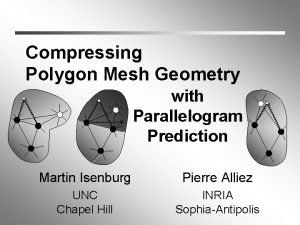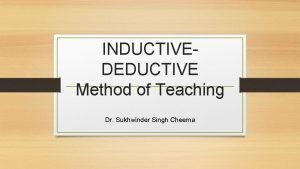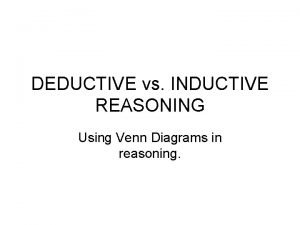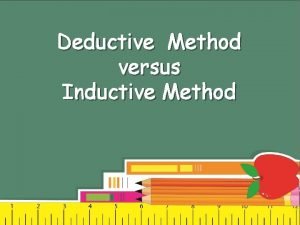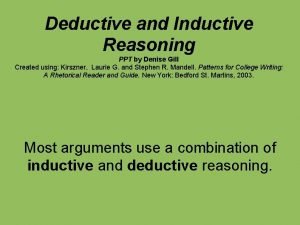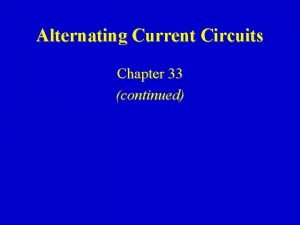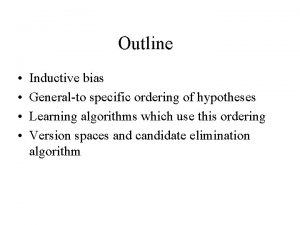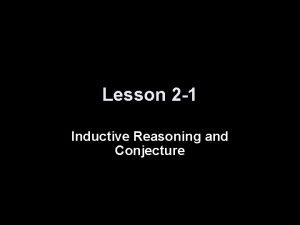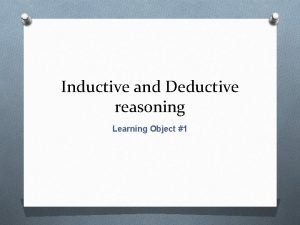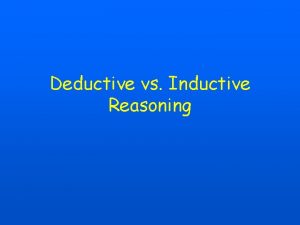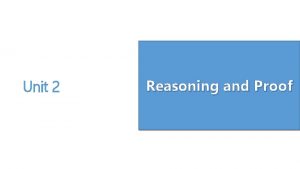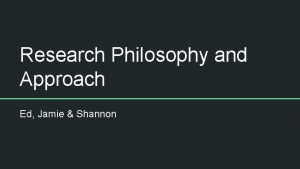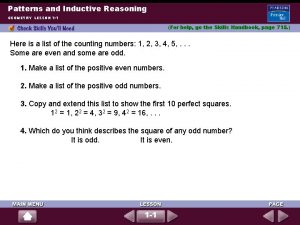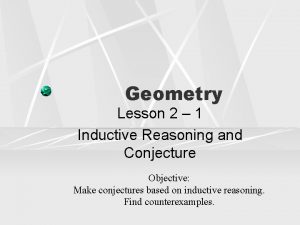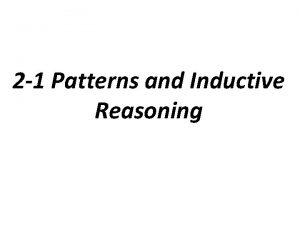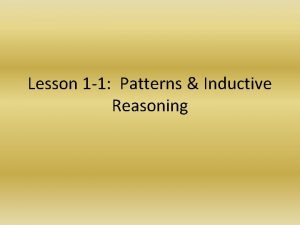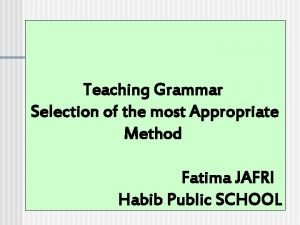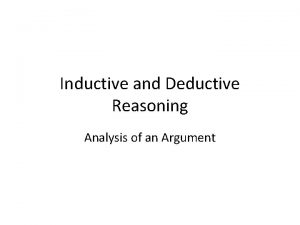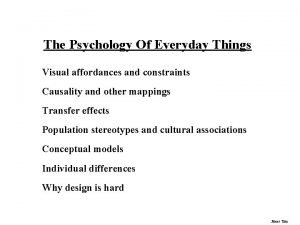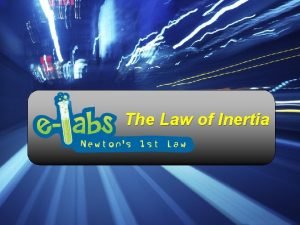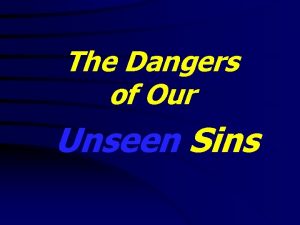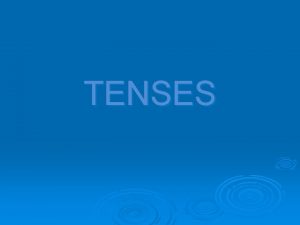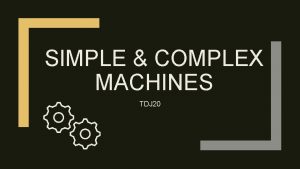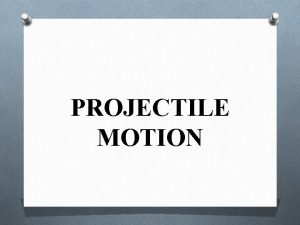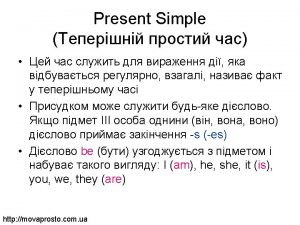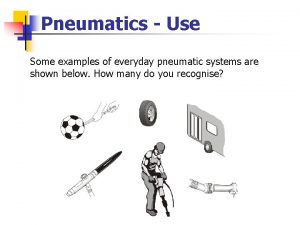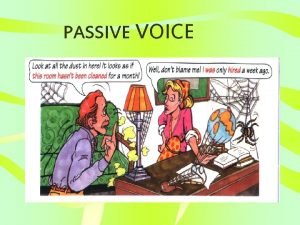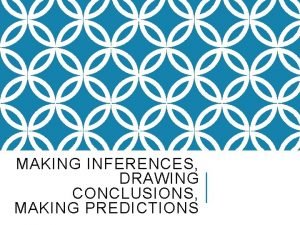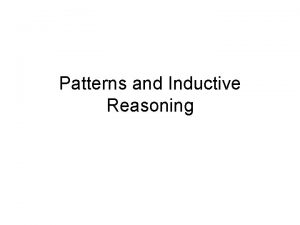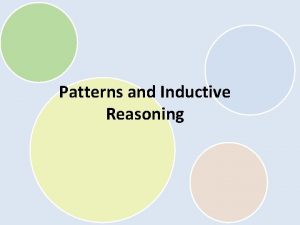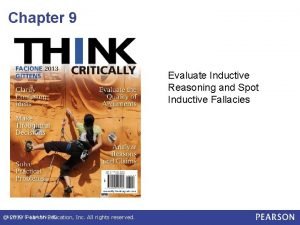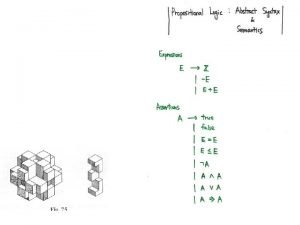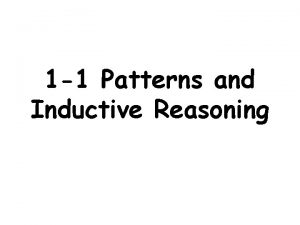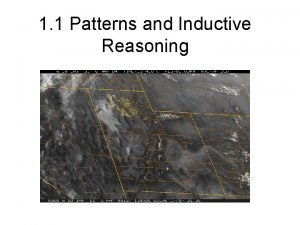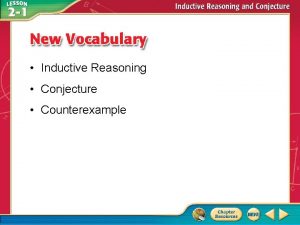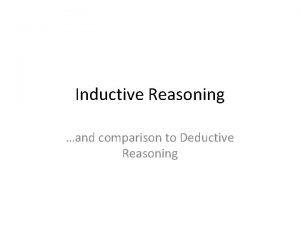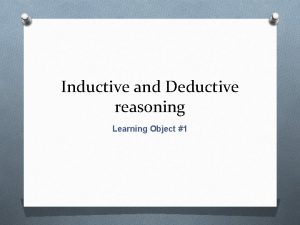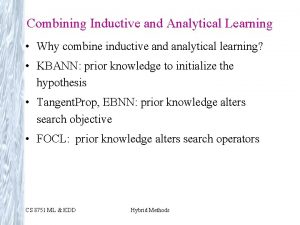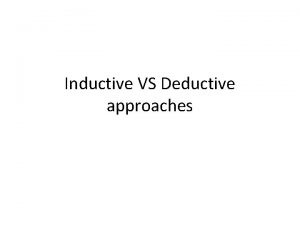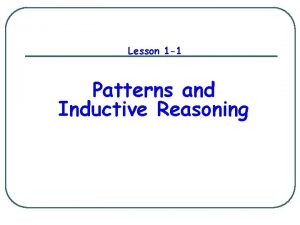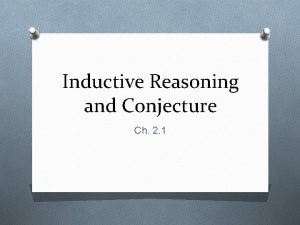Everyday inductive leaps Making predictions and detecting coincidences


































































































- Slides: 98

Everyday inductive leaps Making predictions and detecting coincidences Tom Griffiths Department of Psychology Program in Cognitive Science University of California, Berkeley (joint work with Josh Tenenbaum, MIT)

Inductive problems • Inferring structure from data • Perception – e. g. structure of 3 D world from 2 D visual data hypotheses cube shaded hexagon

Inductive problems • Inferring structure from data • Perception – e. g. structure of 3 D world from 2 D visual data • Cognition – e. g. whether a process is random data hypotheses HHHHH fair coin two heads

Perception is optimal

Cognition is not

Everyday inductive leaps • Inferences we make effortlessly every day – making predictions – detecting coincidences – evaluating randomness – learning causal relationships – identifying categories – picking out regularities in language • A chance to study induction in microcosm, and compare cognition to optimal solutions

Two everyday inductive leaps Predicting the future Detecting coincidences

Two everyday inductive leaps Predicting the future Detecting coincidences

Predicting the future How often is Google News updated? t = time since last update ttotal = time between updates What should we guess for ttotal given t?

Reverend Thomas Bayes

Bayes’ theorem Posterior probability h: hypothesis d: data Likelihood Prior probability Sum over space of hypotheses

Bayes’ theorem h: hypothesis d: data

Bayesian inference p(ttotal|t) p(t|ttotal) p(ttotal) posterior probability likelihood prior

Bayesian inference p(ttotal|t) p(t|ttotal) p(ttotal) posterior probability likelihood prior p(ttotal|t) 1/ttotal p(ttotal) assume random sample (0 < ttotal)

The effects of priors Different kinds of priors p(ttotal) are appropriate in different domains e. g. wealth e. g. height

The effects of priors

Evaluating human predictions • Different domains with different priors: – a movie has made $60 million [power-law] – your friend quotes from line 17 of a poem [power-law] – you meet a 78 year old man [Gaussian] – a movie has been running for 55 minutes [Gaussian] – a U. S. congressman has served 11 years [Erlang] • Prior distributions derived from actual data • Use 5 values of t for each • People predict ttotal

people Gott’s rule empirical prior parametric prior

p(ttotal|tpast) Proportion of judgments below predicted value Probability matching ttotal Quantile of Bayesian posterior distribution

p(ttotal|tpast) Proportion of judgments below predicted value Probability matching ttotal Average over all prediction tasks: • • • Quantile of Bayesian posterior distribution movie run times movie grosses poem lengths life spans terms in congress cake baking times

Predicting the future • People produce accurate predictions for the duration and extent of everyday events • Strong prior knowledge – form of the prior (power-law or exponential) – distribution given that form (parameters) • Contrast with “base rate neglect” (Kahneman & Tversky, 1973)

Two everyday inductive leaps Predicting the future Detecting coincidences

November 12, 2001: New Jersey lottery results were 5 -8 -7, the same day that American Airlines flight 587 crashed

"It could be that, collectively, the people in New York caused those lottery numbers to come up 911, " says Henry Reed. A psychologist who specializes in intuition, he teaches seminars at the Edgar Cayce Association for Research and Enlightenment in Virginia Beach, VA. "If enough people all are thinking the same thing, at the same time, they can cause events to happen, " he says. "It's called psychokinesis. "

The bombing of London (Gilovich, 1991)

The bombing of London (Gilovich, 1991)

John Snow and cholera (Snow, 1855)


(Halley, 1752) 75 years 76 years

The paradox of coincidences How can coincidences simultaneously lead us to irrational conclusions and significant discoveries?

A common definition: Coincidences are unlikely events “an event which seems so unlikely that it is worth telling a story about” “we sense that it is too unlikely to have been the result of luck or mere chance”

Coincidences are not just unlikely. . . HHHHH vs. HHTHTHTTHT

Bayesian causal induction Hypotheses: Priors: cause chance a novel causal relationship exists no such relationship exists p(cause) p(chance) Data: Likelihoods: d p(d|cause) p(d|chance)

Bayesian causal induction Prior odds high low ? high cause low Likelihood ratio (evidence) chance ?

Bayesian causal induction Prior odds high low coincidence high cause low Likelihood ratio (evidence) chance ?

What makes a coincidence? A coincidence is an event that provides evidence for causal structure, but not enough evidence to make us believe that structure exists

What makes a coincidence? A coincidence is an event that provides evidence for causal structure, but not enough evidence to make us believe that structure exists likelihood ratio is high

What makes a coincidence? A coincidence is an event that provides evidence for causal structure, but not enough evidence to make us believe that structure exists posterior odds are middling likelihood ratio is high prior odds are low

HHHHH HHTHTHTTHT posterior odds are middling likelihood ratio is high prior odds are low

Bayesian causal induction Hypotheses: Priors: Data: Likelihoods: cause chance C C E E 1 - frequency of effect in presence of cause 0 < p(E) < 1 p(E) = 0. 5

coincidence HHHHH posterior odds are middling likelihood ratio is high prior odds are low HHTHTHTTHT chance posterior odds are low likelihood ratio is low prior odds are low

Empirical tests • Is this definition correct? – from coincidence to evidence • How do people assess complex coincidences? – the bombing of London – coincidences in date

Empirical tests • Is this definition correct? – from coincidence to evidence • How do people assess complex coincidences? – the bombing of London – coincidences in date

coincidence HHHHH posterior odds are middling prior odds are low likelihood ratio is high cause HHHHHHHHHH posterior odds are high likelihood ratio is very high prior odds are low

From coincidence to evidence coincidence evidence for a causal relation • Transition produced by – increase in likelihood ratio (e. g. , coin flipping) – increase in prior odds (e. g. , genetics vs. �ESP)

Testing the definition • Provide participants with data from experiments • Manipulate: – cover story: genetics vs. ESP (prior) – data: number of heads/males (likelihood) – task: “coincidence or evidence? ” vs. “how likely? ” • Predictions: – coincidences affected by prior and likelihood – relationship between coincidence and posterior

Proportion “coincidence” 55 59 47 51 55 59 63 70 Number of heads/males 87 99 Posterior probability 47 51 63 70 r = -0. 98

Empirical tests • Is this definition correct? – from coincidence to evidence • How do people assess complex coincidences? – the bombing of London – coincidences in date

Complex coincidences • Many coincidences involve structure hidden in a sea of noise (e. g. , bombing of London) • How well do people detect such structure? • Strategy: examine correspondence between strength of coincidence and likelihood ratio

The bombing of London


Change in. . . Number Ratio Location Spread (uniform) People

Bayesian causal induction T X Priors: Data: Likelihoods: chance cause Hypotheses: X X T T T X X X 1 - bomb locations uniform + regularity uniform

Change in. . . People Bayes Number Ratio Location Spread (uniform) r = 0. 98

75 years 76 years

Coincidences in date May 14, July 8, August 21, December 25 vs. August 3, August 3

People

Bayesian causal induction chance cause Hypotheses: B B B B P P P P Priors: Data: birthdays of those present Likelihoods: 1 - uniform + regularity August uniform

People Bayes Regularities: Proximity in date Same day of month Same month

Coincidences • Provide evidence for causal structure, but not enough to make us believe that structure exists • Intimately related to causal induction – an opportunity to revise a theory – a window on the process of discovery • Guided by a well calibrated sense of when an event provides evidence of causal structure

The paradox of coincidences Status of current theory Consequence false significant discovery true false conclusion The utility of attending to coincidences depends upon how much you know already

Two everyday inductive leaps Predicting the future Detecting coincidences

Subjective randomness • View randomness as an inference about generating processes behind data • Analysis similar (but inverse) to coincidences – randomness is evidence against a regular generating process (Griffiths & Tenenbaum, 2003)

Other cases of causal induction A B (Griffiths, Baraff, & Tenenbaum, 2004)

Aspects of language acquisition (Goldwater, Griffiths, & Johnson, 2006)

Probability Categorization x (Sanborn, Griffiths, & Navarro, 2006)

Conclusions • We can learn about cognition (and not just perception) by thinking about optimal solutions to computational problems • We can study induction using the inferences that people make every day • Bayesian inference offers a way to understand these inductive inferences



Magic tricks are regularly used to identify infants’ ontological commitments Can we use a similar method with adults? (Wynn, 1992)

Ontological commitments (Keil, 1981)

What’s a better magic trick?

What’s a better magic trick? Applicable predicates milk water a brick a vase a rose a daffodil a dove a blackbird a man a girl • Participants rate the quality of 45 transformations, 10 appearances, and 10 disappearances – direction of transformation is randomized between subjects • A second group rates similarity • Objects are chosen to lie at different points in a hierarchy

a girl a man a blackbird a man a dove a blackbird a daffodil a blackbird a rose a dove a vase a dove a brick a daffodil water a daffodil a girl a rose a man a rose a blackbird a vase a dove a vase a daffodil a brick a rose a brick a vase water a brick water milk What’s a better magic trick?

a girl a man a blackbird a man a dove a blackbird a daffodil a blackbird a rose a dove a vase a dove a brick a daffodil water a daffodil a girl a rose a man a rose a blackbird a vase a dove a vase a daffodil a brick a rose a brick a vase water a brick water milk Ontological asymmetries

Analyzing asymmetry Applicable predicates milk water a brick a vase a rose a daffodil a dove a blackbird a man a girl • Build a regression model: – similarity – appearing object – disappearing object – contains people – direction in hierarchy (-1, 0, 1) • All factors significant • Explains 90. 9% of variance

Summary: magic tricks • Certain factors reliably influence the estimated quality of a magic trick • Magic tricks might be a way to investigate our ontological assumptions – inviolable laws that are otherwise hard to assess • A Bayesian theory of magic tricks? – strong evidence for a novel causal force – causal force is given low prior probability


A reformulation: unlikely kinds • Coincidences are events of an unlikely kind – e. g. a sequence with that number of heads • Deals with the obvious problem. . . p(10 heads) < p(5 heads, 5 tails)

Problems with unlikely kinds • Defining kinds August 3, August 3 January 12, March 22, July 19, October 1, December 8

Problems with unlikely kinds • Defining kinds • Counterexamples HHHH > HHTT P(4 heads) < P(2 heads, 2 tails) HHHH > HHHHTHTTHHHTHTTHHH P(4 heads) > P(15 heads, 8 tails)


Sampling from categories Frog distribution P(x|c)

Markov chain Monte Carlo • Sample from a target distribution P(x) by constructing Markov chain for which P(x) is the stationary distribution • Markov chain converges to its stationary distribution, providing outcomes that can be used similarly to samples

Metropolis-Hastings algorithm p(x)

Metropolis-Hastings algorithm p(x)

Metropolis-Hastings algorithm p(x)

Metropolis-Hastings algorithm p(x) A(x(t), x(t+1)) = 0. 5

Metropolis-Hastings algorithm p(x)

Metropolis-Hastings algorithm p(x) A(x(t), x(t+1)) = 1

A task Ask subjects which of two alternatives comes from a target category Which animal is a frog?

Collecting the samples Which is the frog? Trial 1 Trial 2 Trial 3

Sampling from natural categories Examined distributions for four natural categories: giraffes, horses, cats, and dogs Presented stimuli with nine-parameter stick figures (Olman & Kersten, 2004)

Choice task

Samples from Subject 3 (projected onto a plane)

Mean animals by subject S 1 giraffe horse cat dog S 2 S 3 S 4 S 5 S 6 S 7 S 8

Markov chain Monte Carlo with people • Rational models can guide the design of psychological experiments • Markov chain Monte Carlo (and other methods) can be used to sample from subjective probability distributions – category distributions – prior distributions

 Xxtttxxx
Xxtttxxx Prediction vs inference venn diagram
Prediction vs inference venn diagram Might for predictions
Might for predictions Good readers making prediction by
Good readers making prediction by Making predictions powerpoint
Making predictions powerpoint Making predictions practice
Making predictions practice Making predictions quiz
Making predictions quiz What is this font
What is this font How is experimental probability used to make predictions
How is experimental probability used to make predictions How to make predictions using theoretical probability
How to make predictions using theoretical probability Making predictions with probability
Making predictions with probability How do you make predictions using experimental probability
How do you make predictions using experimental probability Progress in leaps and bounds
Progress in leaps and bounds Making conjectures inductive reasoning
Making conjectures inductive reasoning Sniffer for detecting lost mobiles
Sniffer for detecting lost mobiles Detecting evolutionary forces in language change
Detecting evolutionary forces in language change Kerberos silver ticket
Kerberos silver ticket How do fraud symptoms help in detecting fraud
How do fraud symptoms help in detecting fraud Havex
Havex My heart leaps up meaning
My heart leaps up meaning Mind leaps
Mind leaps Leaps secondary school
Leaps secondary school Stock replacement strategy
Stock replacement strategy Leaps-innov
Leaps-innov Caged bird metaphors
Caged bird metaphors Principles of verbal judo
Principles of verbal judo Verbal judo 11 things to never say
Verbal judo 11 things to never say War making and state making as organized crime summary
War making and state making as organized crime summary Romeo juliet names
Romeo juliet names Look at the following pictures
Look at the following pictures Going to is used for plans, decisions and intentions.
Going to is used for plans, decisions and intentions. Romeo and juliet predictions
Romeo and juliet predictions What is inferring
What is inferring How to make a prediction on a scatter plot
How to make a prediction on a scatter plot Assumptions generalizations predictions vs. conclusion
Assumptions generalizations predictions vs. conclusion Future simple predictions
Future simple predictions Can you make predictions about tech devices
Can you make predictions about tech devices Animal farm predictions
Animal farm predictions Agatha predictions
Agatha predictions Shape poem of ice cream
Shape poem of ice cream Predictions of progress reading recovery examples
Predictions of progress reading recovery examples Tao lei
Tao lei It's your turn to make predictions
It's your turn to make predictions Ensoel
Ensoel Short. term. crypto. predictions.
Short. term. crypto. predictions. Barry smith predictions
Barry smith predictions Ga lottery predictions
Ga lottery predictions Blackberry stock prices today
Blackberry stock prices today First conditional predictions
First conditional predictions What are the limitations of punnett squares
What are the limitations of punnett squares String theory predictions
String theory predictions Staggered parallelogram mesh
Staggered parallelogram mesh Everyday signs and symbols
Everyday signs and symbols Chapter 6 section 2 supply and demand in everyday life
Chapter 6 section 2 supply and demand in everyday life Everyday alkalis
Everyday alkalis Building health skills chapter 2
Building health skills chapter 2 Inductive v deductive
Inductive v deductive What is deductive method
What is deductive method Deductive reasoning venn diagrams
Deductive reasoning venn diagrams Inductive v deductive
Inductive v deductive Inductive method of teaching
Inductive method of teaching Is the declaration of independence inductive or deductive
Is the declaration of independence inductive or deductive Inductive learning
Inductive learning Vlp
Vlp Deductive reasoning examples
Deductive reasoning examples Inductive bias of candidate elimination algorithm
Inductive bias of candidate elimination algorithm Inductive vs analytical learning
Inductive vs analytical learning 2-1 inductive reasoning and conjecture
2-1 inductive reasoning and conjecture Deductive reasoning
Deductive reasoning Inductive reasoning
Inductive reasoning Venn diagram of inductive and deductive reasoning
Venn diagram of inductive and deductive reasoning Chapter 2 reasoning and proof answer key
Chapter 2 reasoning and proof answer key Jamie shannon
Jamie shannon Inductive reasoning patterns
Inductive reasoning patterns Lesson 1-4 inductive reasoning answers
Lesson 1-4 inductive reasoning answers Geometry lesson 2-1 answers
Geometry lesson 2-1 answers Patterns and inductive reasoning 2-1
Patterns and inductive reasoning 2-1 Practice 1-1 patterns and inductive reasoning
Practice 1-1 patterns and inductive reasoning 2-1 patterns and inductive reasoning worksheet
2-1 patterns and inductive reasoning worksheet Advantages and disadvantages of inductive method
Advantages and disadvantages of inductive method Inductive reasoning examples
Inductive reasoning examples Whats inductive reasoning
Whats inductive reasoning Inductive reasoning deductive reasoning
Inductive reasoning deductive reasoning Critical thinking examples in everyday life
Critical thinking examples in everyday life Psychology of everyday things
Psychology of everyday things Sir isaac newton law of inertia
Sir isaac newton law of inertia Examples of everyday sins
Examples of everyday sins I study english everyday simple present tense
I study english everyday simple present tense Examples of social interaction in everyday life
Examples of social interaction in everyday life Examples of complex machines used in everyday life
Examples of complex machines used in everyday life Does weight affect projectile motion
Does weight affect projectile motion He play football present simple
He play football present simple Pneumatic example
Pneumatic example Physical changes in everyday life
Physical changes in everyday life Rhetorical strategies
Rhetorical strategies Everyday performance management
Everyday performance management I played football yesterday
I played football yesterday My mother washes the dishes everyday
My mother washes the dishes everyday Make everyday mediterranean
Make everyday mediterranean
